From: Tain to Dornoch
Distance: 9m / 14.4km
Cumulated distance: 1110m / 1786km
Percentage completed: 93.4

The little we saw of Tain as we left was very pretty. The town was granted its first royal charter in 1066, making it Scotland’s oldest Royal Burgh. When King Malcolm III granted the charter it confirmed Tain as a sanctuary, where people could claim the protection of the church. Robert the Bruce for example, sent his both his wife and his daughter there for safety, during the first Scottish War of Independence. (Although, sadly in their case, the protection was a woeful failure). The town also offered immunity for resident merchant and traders, who were given exemption from certain taxes. As a result the town boomed and became prosperous.

Royal Tain Hotel
Tain won the charter largely because of its big celebrity resident, Duthac. He was an early Christian figure who was honoured with a shrine at Tain. It was a shrine that was much visited by pilgrims, especially after Duthac became an official saint in 1419. King James IV would come at least once a year throughout his reign to worship. There were street names, community centres and buildings all over the place bearing the Duthac name .. superb branding with extraordinary longevity.
Gus was wonderful in finding two terrific remedies for my foot today. He started by taking his scissors … and strapping my foot with his sports tape. There was an undoubted improvement as I walked.
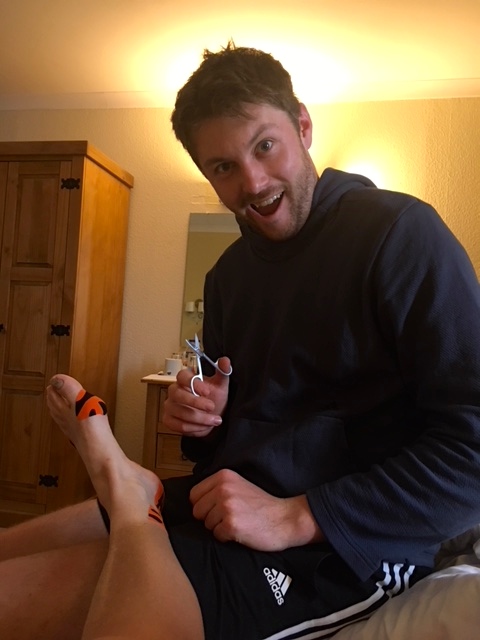
‘Saint’ Angus, complete with halo, wielding his scissors and tape
And the second remedy .. well, I’ll leave him to explain.
I think Mum has passed over the responsibility of writing about our time at Glenmorangie not because I’m more knowledgeable about whisky or because she felt I should pull my weight on the blog writing side of things. I suspect it’s more likely because the time during and shortly after our visit, passed in a pleasantly fuzzy haze for her. After having passed Dalmore Distillery yesterday, I was determined that we make a stop at one of the most famous distilleries in the world.
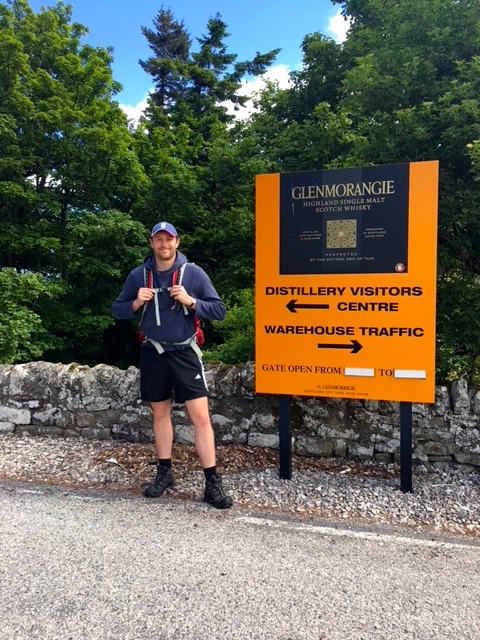
Happy
The distillery is situated overlooking the coastline which for most of the year affects a moody, brooding air. However, today the sun was up and shining as we made our way past a coach tour of happy pensioners and into the tasting room. Being a new-comer to whisky and never having tried the Glenmorangie 10, I thought Mum should taste that along with the honeyed tones of the Nectar d’Or and the refined and decidedly sumptuous Signet.
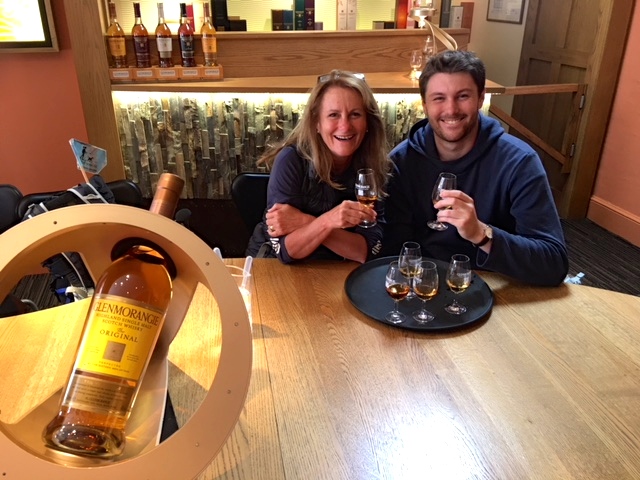
Elevenses ..
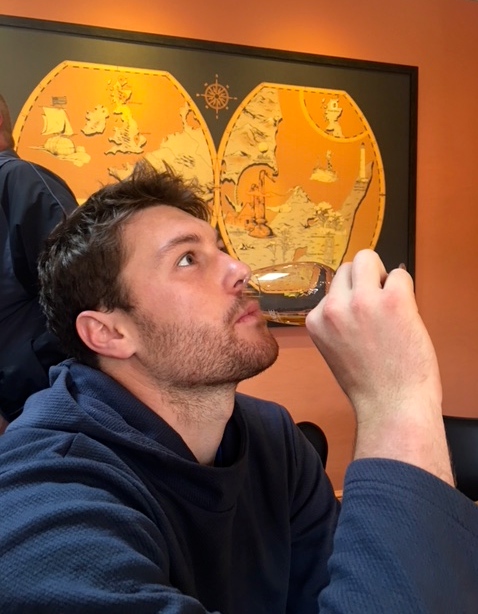
The heavenly Signet
As Mum found out, to her detriment and to my amusement, three ‘wee drams’ was a little more than she had bargained for. We were joined in our tasting room by the group of Scottish oldies. Half an hour later we left them enjoying their whiskies, singing Celtic football club songs, all with gusto. This brought a smile to both of our faces, although the guide was rather grumpy as he told me that he was a Rangers fan.
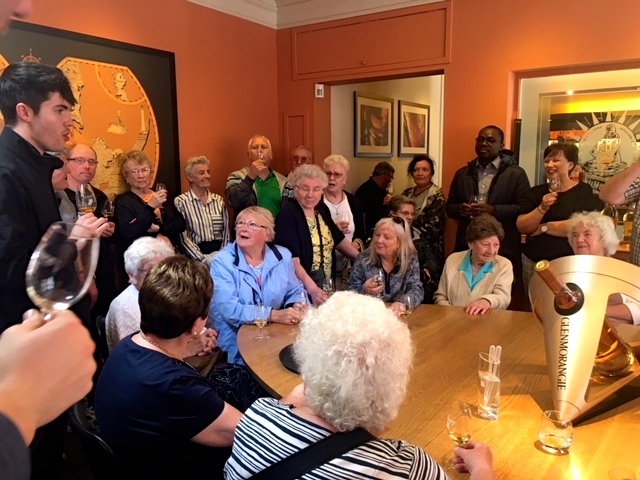
‘This land is your land ..’
As we tottered away, a little worse for wear after our wee drams, Mum mused to me, ‘my foot feels a lot better .. I wonder if there’s a distillery in the next town to start the day off’.
Well, thanks Gus. I will just say in my defence, that my son promised me there would be coffee and cake at Glenmorangie to soak up any excess whisky. There was not a cafe in sight.
William Mathson was the chap who founded the Glenmorangie Distillery in 1843, employing ‘The Men of Tain’ to produce a ‘complex and exceptionally smooth’ single malt whisky. To be a single malt scotch, whisky must have been distilled at a single distillery using a pot still distillation process and must be made from a mash of malted barley. It must be distilled in Scotland and matured in oak casks in Scotland for at least three years and one day. Not a mili-second less!
The earliest documented record of distilling in Scotland occurred as long ago as 1494. By the early 1700s, increasing taxes on whisky were ruffling the kilts of Scottish distillers, who outwardly rebelled or went underground – literally. ‘Clandestine stills were hidden in the heather-clad hills, and smugglers organised signalling systems from one hilltop to another whenever excise officers were seen,’ says the Scotch Whisky Association. Smuggling became the mother of invention as all manner of creative ruses were conceived. Ministers of the kirk made storage space available under the pulpit, and the illicit spirit was occasionally even transported by coffin!
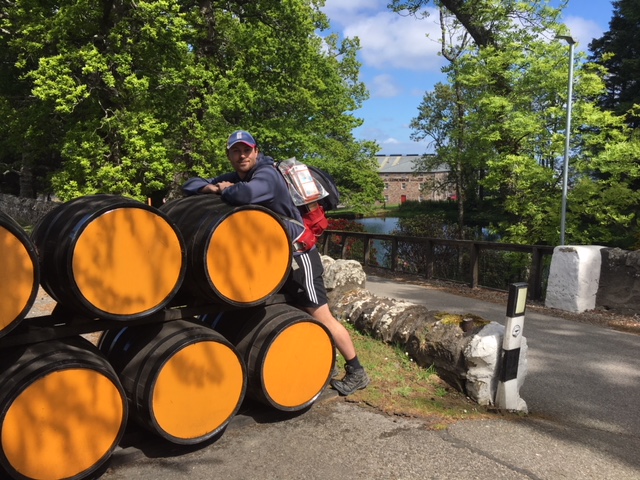
The signature orange casks of Glenmorangie

Weaving our way to Dornoch Bridge
After following a little B road we had no choice but cross the Dornoch Firth using the A9 Bridge. Looking inland we could see the golf course of Skibo Castle and if we squinted we could just about make out the grey stone of the castle. It’s a splendid place which I’ve had the great fortune to stay at a couple of times with dear friends. Behind the castle is the delightfully named Struie Hill. We walked to the top a few years ago.
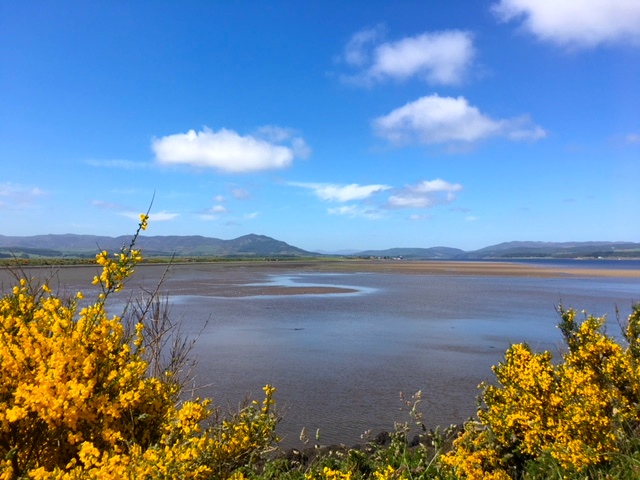
Views towards ..
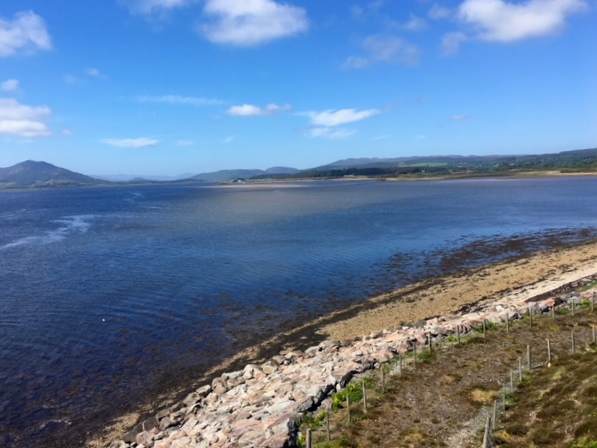
Skibo
Once across the bridge the expansive Cuthill and Dornoch Sands come into view to the south, looking spectacular. Despite their beauty today it’s easy to imagine just how bleak they would appear on a less sunny day. The gorse created great clouds of yellow and their heady scent of honey was reminiscent of the whisky we’d tasted earlier in the day.

Towards the North Sea
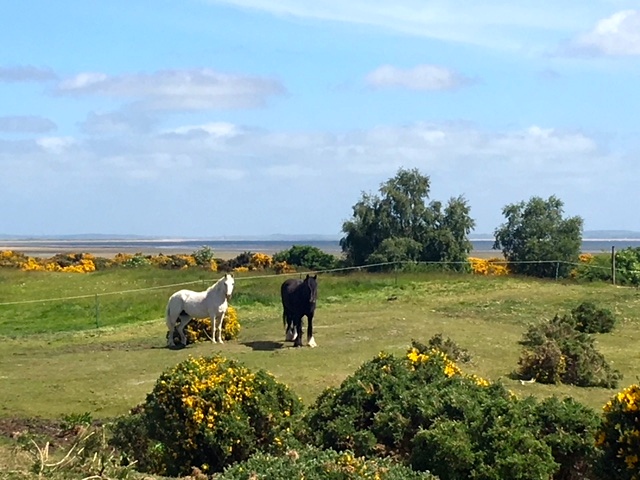
Horses everywhere .. some real and ..
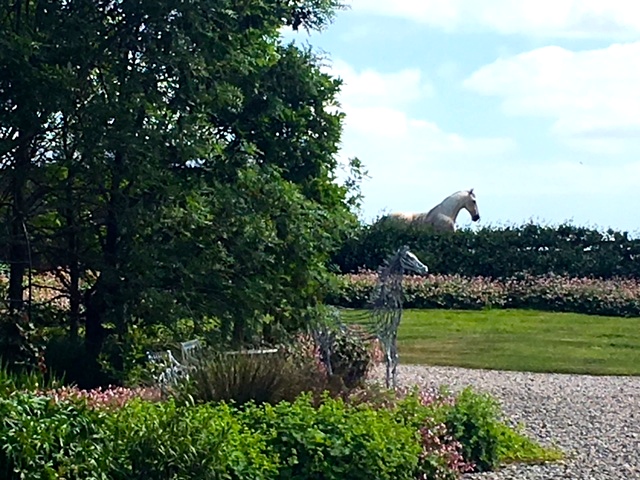
.. some not
Getting closer to Dornoch we kept an eagle eye out for the ‘standing stone’ in a field which marks the spot where St Gilbert, Bishop of Caithness slew the Dornoch dragon with a bow and arrow, way back in the 13th century. The dragon apparently, ‘had a penchant for plump little girls; he was a lengthy brute, with a long neck, and as he lumbered along the street he would put his head in at a window, and gobble up a fair maiden. No one dared to attack the beast, for he could spout flames’.
But then along came Gilbert with a cunning plan. He had a long shallow tunnel dug in the dragon’s path. It had several peep-holes at regular intervals. As the ravenous beast approached, Gilbert took up his post at the first hole and shot his first arrow into the chest of the animal. Then he quickly scuttled to hole number two, swiftly blocking his way behind him. From the hole he could see the dragon spouting flames into the first hole. Gilbert followed this procedure up to the end of the tunnel .. shooting then blocking, shooting then blocking .. until the dragon was no more. Job done.
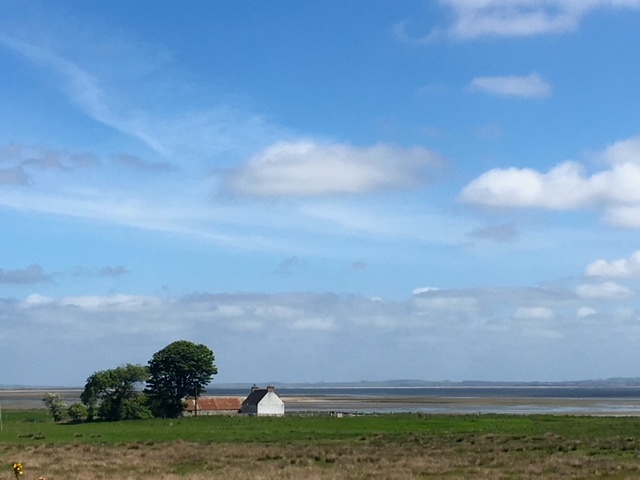
The standing stone .. out there somewhere
Dornoch has a cathedral and a castle. The original cathedral was built on St Gilbert’s watch, in fact. Sadly, fire created another link to Gilbert when the cathedral was burnt down in the 15th century. It took a couple of hundred years before it was renovated. Elon Musk of Tesla fame and much besides, was married in the cathedral in 2010.

Dornoch cathedral
I mentioned that Dornoch also had a castle .. and that is exactly where we are sleeping tonight! Lucky us.
Black Dog Tails
Velvet may well have saved the lives of 3 stranded mountaineers on Mount Hood, when she took it turns to lie across their bodies and keep them from the onset of hyperthermia.
http://www.nbcnews.com/id/17219953/#.Wb4i5RRAWyo
![]()




Enjoying the new reporter’s slant on the walk! Or should that be walking on a slant, after the Glenmorangie?!
Ha ha!! I was happy either way.
I must recommend Scotch to my clinical colleagues as treatment for plantar fasciitis. But meanwhile I looked to see what Mr Amazon has to offer (as you do) and there seems to be a big range of items which promise support and pain relief. Can I use my Prime account to send something to your next overnight stop? Special socks, arch support gel pads, massage roller? Let me know if you think anything might help.
How kind are you! I’ve taken a look at some of the things you talked about and ordered myself some of the gel heel thingies. Thought it would be quicker for me to order but thanks so much for your thoughtfulness. x
Hope they help x
Aaah Glenmorangie (sigh). Well at least with Angus there we now get to read the real goings on. Keep it up Angus.
So mean! I think you’d like this part of the journey, Marak. x
Good to hear about the foot repairs – sounds like it comes from some experience? Years ago you could buy Elastoplast in 1 metre lengths about three inches wide (sorry about mixing metric and Imperial) which was useful for proper strapping, but it seems to be no longer available. Your photos and descriptions, and the benefit of good weather and clear air bring all the Sottish atmosphere back to me.
It seems egotistical to keep quoting my own experiences, but It’s too far gone now to stop, so here is the continuation of the same day from yesterday’s snippet after I had emerged from the gazebo fifteen miles from nowhere:
“I walked on down this long estate road to an estate house called The Glutt where I met a keeper digging a trench. My
other boot sole had come off from the heel like the other one earlier and I had temporarily fixed it with some bailing twine. I asked this keeper if he had a couple of wood screws, but he said no and his outlook was negative. It seemed a bit out of context when he told me he had been off to Donnington to watch motor bike racing a few days ago; what a journey.
When I got to Dail Righe, the recommended wild camp site, it didn’t look so good and I carried on. I was just following aLand rover track cut though the moorland with no variation on either side offering absolutely nowhere to camp. At last I came to Loch More where there was a golden sandy northern shore and I put the tent up on the sand. The pegs were not secure, but despite a windy night it all remained intact. I had walked nearly the whole of this fifteen mile estate road, and so my journey to Watten tomorrow had been reduced from about twenty miles to thirteen. I had carried two litres of water from a stream mentioned in the guide for about two miles and I used it all during the evening.
You did it much tougher than me, Conrad! Respect.
Jules , it sounds like several glasses of whisky 🥃 and taping are a great combination to address your foot pain ! Way better than voltaren cream . So happy to see that you are in Gus’s very capable hands , clever boy . Ending the day in a castle is precisely what you deserve my friend ! Xx
Well, they’re just an alternative to your magic massages and the voltaren, I think! xx
I can only refer the reader to my comments of yesterday regarding Jules’ distressing lack of resilience to the siren song of that work of the devil, the Scotch spirit!
But Tigger, it’s purely medicinal isn’t it?!
Tigger and I was thinking of you yesterday, as we climbed the steps up from Monterosso to Vernazza here in Cinque Terre. According to the Health app on my phone, we climbed 86 floors, which was jolly hard work. It gave us a bit more of an insight to your first days of you epic journey, just to how gruelling it is on ones body and how much it takes it out of one.
However, we had lovey sunshine. You had snow or deep mud on the ground, howling winds with sleet, rain and snow, at times horizontal. You were carrying a heavy backpack, with no company, just the lonely path, beautiful views, nerves and fear, especially on day really hard day, as your day 12 was.
Then on day 13, was the first time you mentioned your aching body……
You are on day 85, with only a few days to go. Your poor body has been through a gruelling time, your foot is supposed to be up and resting and yet, you are soldiering through, and to make the last few days more special, with someone to help you, is Gus. How wonderful.
Jules, I am in awe of you, what you have achieved, your resolve, determination, guts and determination. All with honesty, homer and at times tears. You are amazing my dear friend.
Ils, thanks for the loveliest of messages .. so kind of you .. I barely recognised me. I know you could do just the same though, oh black belt woman! Much love Jxxx
Another world Jules we have been so privileged to see through your eyes – thank you! Lots of love xx
Very happy to share it, Frannie .. so encouraged by your daily messages.xx